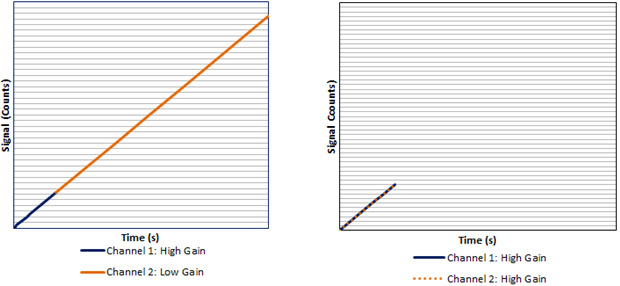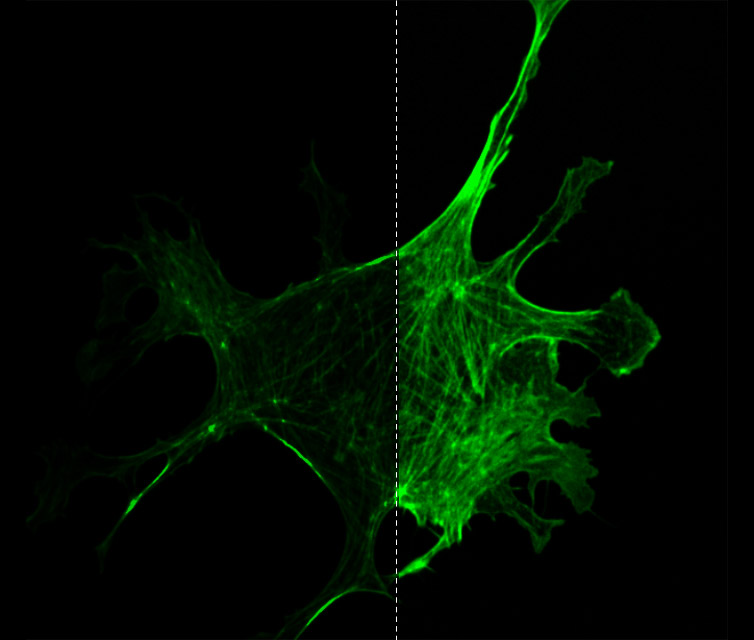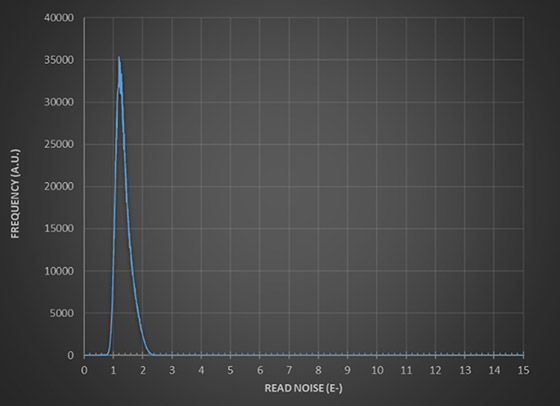Resources
 Part of the Oxford Instruments Group
Part of the Oxford Instruments Group
Expand
Collapse
 Part of the Oxford Instruments Group
Part of the Oxford Instruments Group
The Sona-6 features 3 modes of operation as of November 2022:
The low noise mode of the Sona-6 series is intended for applications that have the weakest signals and thus need the highest possible sensitivity. The low noise mode of the Sona-6 series uses a two times correlated multisampling (2-CMS) approach so that the lowest noise floor can be achieved while still maintaining high frame rates. Therefore, it is perfectly suited for live cell and confocal imaging applications that seek to reduce illumination intensities and use short exposure times to minimize adverse effects on cell biology.
The Components of Readout Noise
During the normal sensor readout process, noise is generated by the sensor itself termed “read noise”. Although the amount of read noise in modern sCMOS sensor designs is very low it does set a limit on the noise floor and ultimately impacts the sensitivity of the camera i.e. the ability of the camera to detect very low signal levels against the noise component.

Figure 1: The read noise of scientific cameras is very low. However, when the signal level and the signal to noise ratio are reduced (right) then the read noise of the camera imposes a limit to the sensitivity.
The read noise itself comes from two main sources: from the amplifiers that increase the low-level signal so it can be further processed which is termed “amplifier noise”, and from each time charge is cleared from the pixel, which is termed “reset noise”. In the case of sCMOS cameras, this read noise is expressed as a distribution as a median or rms figure since each pixel effectively has its own circuit and thus noise value. This is discussed in the technical note, understanding read noise in sCMOS.
How can we overcome Read Noise and Improve the Signal to Noise Ratio?
There are several practical ways to improve the signal to noise ratio, two common examples of which are:
Another strategy is to tackle the source of the read noise itself. The reset noise component is commonly reduced in digital circuits (including sCMOS cameras) using correlated double sampling (CDS), leaving the amplifier noise as the main component. The amplifier noise could be reduced by taking multiple samples of the signal in a process called correlated multi-sampling (CMS). The potential downside of this approach is that with multiple samples being taken through a single read channel the frame rate of the sensor could be reduced. While this may work for fixed cells it would not be suitable for many live cell imaging applications.
Maintaining speeds at low noise using 2-CMS noise reduction
Under normal operation, sCMOS sensors with dual channel amplifier circuits the upper and lower readout channels act in a low gain (for high level signals), and a high gain (for low level signals) channel format. These can be used in a single channel format or combined to give a full image data range (Figure 2). Combing the 2 gain channels effectively is difficult, but used in this way, sCMOS cameras can provide a much higher dynamic range capability when compared to CCD and EMCCD cameras. From a practical microscopy point of view it means more samples are in range more often with less adjustments and reimaging due to “oversaturated” or “too dim” samples. For Andor Sona cameras they exploit an exclusive technology termed “Extended Dynamic Range” to achieve a more linear and thus wider effective dynamic range than other cameras employing the same sensor.

Figure 2: An sCMOS sensor with a dual channel amplifier, such as the Sona shown here, can use 2 gain channels to reconstruct a 16-bit image from the information sampled using the 2 channels. This provides an exceptional dynamic range.
The GS2020BSI sensor used in the Sona 4.2B-6 (and the Marana 4.2B-6) also allows a further configuration of the 2 gain channels. In the configuration used for 2-CMS, both readout channels act as “high gain” channels, shown in Figure 3. By taking a sample from each channel at the same time, the read noise level can be cut by a factor of √2. This equates to a reduction in the normal read noise of the GS2020BSI sensor from ~1.6e- [1.8e-rms] to ~1.2e- [1.3e- rms].

Figure 3: A simplified representation of how the Gain Channels are configured for 16-bit and for 2-CMS mode in the GS2020BSI Sensor.
What are the benefits and tradeoffs to using 2-CMS?
The 2-CMS method uses the 2 separate channels to sample the signal at the same time and so provides a meaningful reduction in read noise without the penalty of greatly reduced frame rates to achieve a very low noise. What is the downside to this implementation of noise reduction? The tradeoff made for this method is signal handling capacity, or dynamic range. Since the 2 gain channels are now high gain channels rather than high and low gain channels working together in 16-bit HDR mode, the signal handling capacity will be reduced to that of the single high gain channel (Figure 4). For many applications that involve very weak signals however the range in counts of the signal may be over a relatively small range of ~500 meaning that the low noise mode should be the default mode for best image quality at short exposures unless the sample has information over a much wider range. In these cases the HDR mode should be selected.

Figure 4: By effectively using 2 high gain channels to perform 2-CMS the read noise is reduced at the expense of dynamic range (above right).
| GS2020BSI Sensor Parameter | Sensor Mode Sona 4.2B-6 | ||
| Method | Low Noise (2-CMS) | High Dynamic Range (HDR) | High Speed (HS) |
| Bit depth | 12-bit | 16-bit | 11-bit |
| Max frame rate (fps) | 43 | 74 | 135 |
| Normal Mode Read Noise (e- median) | 0.9-1.0e- [1.1e- rms]. | ~1.6e- [1.8e-rms] | ~1.9e- [2.0e-rms] |
| Well depth (e-) | 1,100 | 55,000 | 1,800 |
Table 1: Standard specifications of the GSENSE2020BSI sensor in 2-CMS mode compared to HDR mode configuration as specified by sensor manufacturer.
In table 1 we can see that read noise in 2-CMS mode is reduced compared to the HDR and HS modes. While maximum frame rate is reduced, at 43 fps it is still sufficiently fast for most applications. The main compromise of running in low noise mode is therefore the reduction in well depth. This makes maximizing the effective well depth in this mode very important. Andor has optimized the 2-CMS mode implementation to allow the full potential well depth and linearity to make this low noise mode more suitable to a wider range of samples than would be found in other cameras using the same sensor. This allows the Sona-6 to have a wider window of operation and function more effectively in this imaging mode. Furthermore, as for full range 16-bit image data, the quantitative accuracy is also higher (>99.7%) for the Sona-6 which is critical for quantitative measurements such as FRET or other ratiometric datasets.

Figure 5: The low noise mode of the Sona 4.2B-6 has been optimized for best performance at low light levels. This can be demonstrated on low light samples – in this example the widely used FluoCells #1 BPAE cells (Invitrogen) were imaged with very low exposure time to provide a simple comparison.
As outlined above, the low noise mode of the Sona 4.2B-6 is well suited to live cell imaging that seeks to reduce illumination intensities and use as short exposure times as possible to minimize adverse effects on the cell biology being studied.
How Sona provides further improvements in sensitivity
In addition to low noise using 2-CMS mode, and high quantum efficiency provided by back-illumination, the Sona camera series also features careful and precise optimisation of each camera so that the best possible performance of the sensor can be obtained. In addition, a key feature of Sona is the deep and stable cooling capacity that is enabled by exclusive vacuum technology. This unmatched ability to cool the sensor has two important effects on camera noise:

Figure 6: Sona-4.2B-6 has excellent noise characteristics resulting in a cleaner image and less need for interpolative filters.
Sona-6 has an exceptional noise performance achieved due to optimized implementation of the GS2020BSI sensor that results in high sensitivity, highest quantitative accuracy and the lowest possible noise for cameras in it’s class. This translates into the cleanest possible image with the minimum of additional image filters being required.
Sona low noise 2-CMS Mode benefits:
Date: January 2023
Author: Dr Alan Mullan
Category: Technical Article
